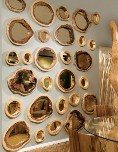New market idea: Selling woody materials from landscaping projects to craft industry
ID
ANR-215NP
Introduction
With recent fashion and home décor trends focusing on natural found elements, a potential market opportunity for the landscaping industry is emerging (HGTV.com, 2016). Media promotion of fashion and home décor termed as: forest chic, gypsy or “Boho” (also known as Bohemian) forest, rustic luxe, and vintage farmhouse inspire event planners and cottage crafters to create nature inspired events and natural crafted items. Millennial consumers contribute to nature inspired trend adoption by incorporating natural wood elements into home construction and furnishings to blend a vintage vibe with modern design for mainstream aesthetic appeal.
Landscape businesses may find lucrative opportunities in partnering with the crafting industry, decorators, event planners, or home crafters to sell tree materials in the form of natural, dried stumps, twigs, and branches left over from landscaping projects for use in various crafting applications. Cobranding created items with specific landscape business branding and creating a business webpage link to other craft business webpages may also encourage new business leads.
Perceived Environmental Benefit
The United States Composting Council (2008) estimated 13% of the national landfill waste stream is comprised of yard trimming debris equating to 31M tons per year diverted to American landfills. According to Eleazer (1997), only 29% of tree branch materials decompose in a landfill setting. The use of reclaimed wood from landscaping companies promotes recycling in the form of “upcycling” and may increase consumer perceived value of what once was considered waste to be thrown in a landfill or burned. Chakravarty, Puri, Pala, and Shukla (2015) suggested the use of processed or value-added harvested wood products may contribute to greenhouse gas mitigation by serving as a carbon sequestration source.
Price Discovery
Online pricing of reclaimed wood décor items range from less than one dollar to over $1,000 or more. There is crafting potential for every budget, small to extravagant. Creative applications for natural wood cuttings and stumps left over from landscaping are seemingly endless and limited only by imagination.
Recommendations
Special attention should be placed on wedding event planners and brides who may be interested in using natural wood items in decorating and wedding favors. Working with craft supply retailers, home crafters, artisan cottage businesses, and art class teachers is also encouraged. Developing a virtual photo catalog of potential crafting or décor ideas using social media platforms such as Instagram or Pinterest may encourage interest and bulk sales. A variety of different décor items are presented in Table 1. To view the reference source of the pictures contained in Table 1, click on the specific picture of interest.
References
Chakravarty, S., Puri, A., Pala, N. A., & Shukla, G. (2015). Mitigate climate change and use processed or value-added harvested wood products. In A. B. Sharangi and S. Datta (Eds.), Value addition of horticultural crops: Recent trends and future directions (pp. 245-267). India: Springer.
Eleazer, W.E., O. Williams, W. Yu-Sheng, & M. Borlaz. (1997). Biodegradability of municipal waste components in laboratory-scale landfills. Env. Sci. and Tech., 31(3), 911-917.
HGTV.com. (2016). Natural wood décor. Retrieved from http://www.hgtv.com/search/natural-wooddecor-
US Composting Council. (2008). Keeping organics out of landfills. Retrieved from http://compostingcouncil.org/admin/wp-content/uploads/2011/11/Keeping-Organics-Out-of-Landfills-Position-Paper.pdf
Virginia Cooperative Extension materials are available for public use, reprint, or citation without further permission, provided the use includes credit to the author and to Virginia Cooperative Extension, Virginia Tech, and Virginia State University.
Virginia Cooperative Extension is a partnership of Virginia Tech, Virginia State University, the U.S. Department of Agriculture (USDA), and local governments, and is an equal opportunity employer. For the full non-discrimination statement, please visit ext.vt.edu/accessibility.
Publication Date
June 30, 2021























